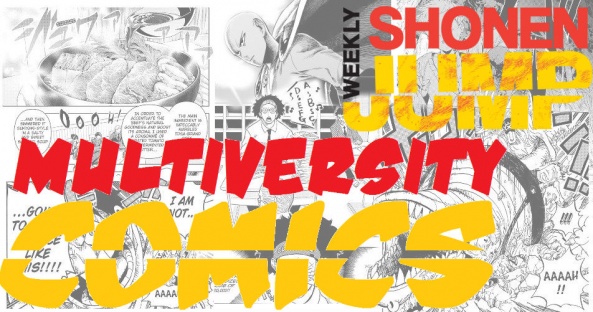
Welcome to This Week in Shonen Jump, our weekly check in on Viz’s various Shonen Jump series. Viz has recently changed their release format, but our format will mostly remain the same. We will still review the newest chapters of one title a week, now with even more options at our disposal. The big change for our readers is that, even without a Shonen Jump subscription, you can read these most recent chapters for free at Viz.com or using their app.
This week, Brian checks in with “Sho-Ha Shoten!.” If you have thoughts on this or any other current Shonen Jump titles, please let us know in the comments!

Sho-Ha Shoten! Chapter 24
Written by Akinari Asakura
Illustrated by Takeshi Obata
Lettered by James Gaubatz
Translated by Stephen Paul
Reviewed by Brian Salvatore
The structure of “Sho-Ha Shoten!” has been relatively predictable once the series moved into the more tournament-based stories, but this issue continues a plot thread from ‘Chapter 23’ that seeks to take the focus, temporarily away from the tournament. Taiyo appears to have either been bribed or pressured into throwing One Way Ticket to the Top’s performance. While this series has certainly had chapters about Taiyo before, his dedication to Azemichi has never really been questioned before, which sets the two leads on a path that is vastly different from the conflicts that take up most of the page count.
Those other conflicts, for this chapter, are made up of the frequent combination of origin and performance for other teams, in this case the performance of Kamikaze Yellowtail and the origin of Mochizuki’s team. The comedy segments of “Sho-Ha Shoten!” are always hit and miss because of the dual difficulties in trying to craft actually funny routines and then doing so through translation. Kamikaze Yellowtail’s routine has a familiar premise of the loudmouth and the unnaturally quiet performer, but beyond that, the laughs are more or less missing from the chapter.
The story of Mochizuki gets the bulk of the issue and, while it is a different type of origin story for one of these performers, there’s only so much we can be expected to care for a character we’ve just met and who is direct competition with the characters we’ve been reading for two years now. Akinari Asakura tries to give Mochizuki motivation for his performance, but does so through the story of an even less established character who we will likely never see again. This feels too far removed for the reader to really care about, in terms of giving them a reason to cheer or boo Mochizuki. The most notable thing this piece does is establish ‘No dice, monkey dick” as one of the best insults in Shonen Jump in 2023, as well as a new phrase to slip into all of our back pockets.
This chapter also establishes Broken Glass Slipper as the team to beat, despite drawing the first slot in the competition. Again, this is where “Sho-Ha Shoten!” reveals itself as a sports manga, despite being focused on comedy, not athletics. The structure of the story is clearly sports manga, but instead of the challenge of artistically depicting athletics, Takeshi Obata is tasked with creating visual comedy from a script that may be relying on the words for the laughs. This leads to Obata having to make certain panels so over the top that they can read as zany and bizarre. But the visuals are rarely the issue here, especially when considering the amount of heavy lifting the art has to do for audiences not reading in Japanese.
Final Verdict: 6.1 – A valiant effort to expand the scope of the story, but “Sho-Ha Shoten!” needs to remember who the manga is focused on, and give the reader more of them.






